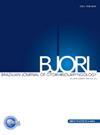Longitudinal study of hearing preservation and electrocochleography after cochlear implantation in adults
IF 1.7
4区 医学
Q2 OTORHINOLARYNGOLOGY
引用次数: 0
Abstract
Objectives
Electrocochleography (ECOG) is a composite objective measure of the cochlea and the cochlear nerve responses. The objectives of this study were to investigate the evolution of ECOG after cochlear implantation and compare them with audiometric thresholds over a 12-month period.
Methods
A prospective monocentric study was conducted in Advanced Bionics cochlear implant recipients. Audiometric thresholds were recorded preoperatively and at 1-, 3-, 6-, and 12-months post cochlear implantation; ECOGs were recorded perioperatively after the electrode array insertion and at 1-, 3-, 6-, and 12-months post cochlear implantation. Cochlear Microphonic (CM) responses were measured by an apical electrode of the cochlear implant. Postoperative behavioral and ECOG thresholds were compared using Pearson correlation analyses.
Results
A total of 17 patients were included. At 1-year, residual hearing (≤90 dB HL at 500 Hz) was preserved for 4 out of 17 patients. Significant correlations were observed between perioperative ECOG and preoperative audiometric thresholds (p = 0.008), and between ECOG and audiometric thresholds at 3-months postoperative (p = 0.002).
Conclusion
ECOG can reflect changes in cochlear responses during and after implantation and may help to predict deterioration of residual hearing.
Level of evidence
Level 3.
成人人工耳蜗植入术后听力保护和耳电图纵向研究
本文章由计算机程序翻译,如有差异,请以英文原文为准。
求助全文
约1分钟内获得全文
求助全文
来源期刊

Brazilian Journal of Otorhinolaryngology
OTORHINOLARYNGOLOGY-
CiteScore
3.00
自引率
0.00%
发文量
205
审稿时长
4-8 weeks
期刊介绍:
Brazilian Journal of Otorhinolaryngology publishes original contributions in otolaryngology and the associated areas (cranio-maxillo-facial surgery and phoniatrics). The aim of this journal is the national and international divulgation of the scientific production interesting to the otolaryngology, as well as the discussion, in editorials, of subjects of scientific, academic and professional relevance.
The Brazilian Journal of Otorhinolaryngology is born from the Revista Brasileira de Otorrinolaringologia, of which it is the English version, created and indexed by MEDLINE in 2005. It is the official scientific publication of the Brazilian Association of Otolaryngology and Cervicofacial Surgery. Its abbreviated title is Braz J Otorhinolaryngol., which should be used in bibliographies, footnotes and bibliographical references and strips.
 求助内容:
求助内容: 应助结果提醒方式:
应助结果提醒方式:


